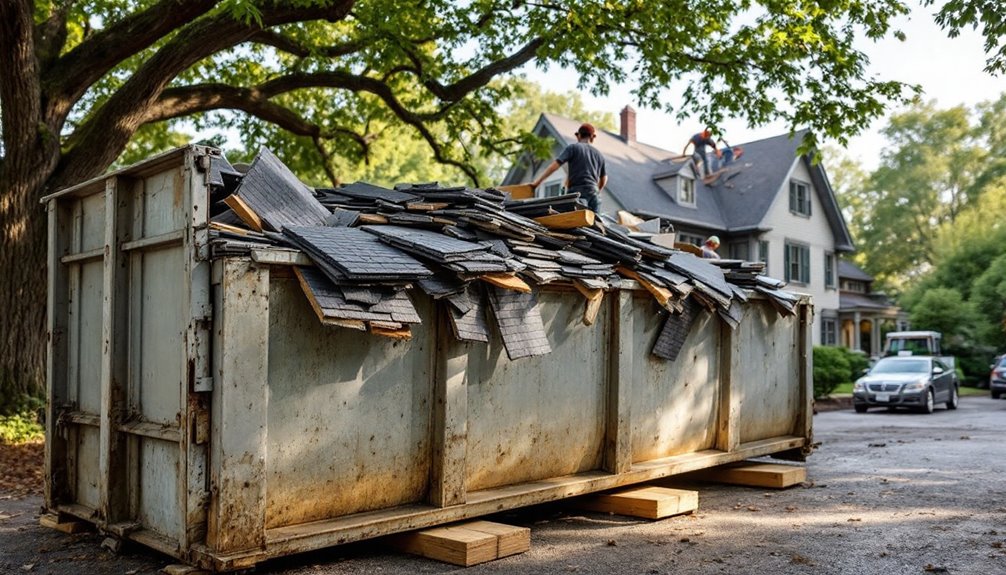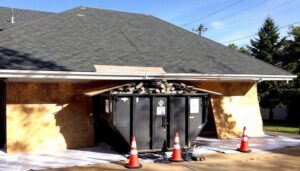You’ll need a dumpster rental for your roofing project to keep your worksite safe and organized while properly disposing of materials. Choose your dumpster size based on roof square footage – a 10-yard for small jobs up to 40-yard for commercial projects. Schedule at least two weeks ahead, guarantee proper placement for easy access, and follow local disposal regulations. Understanding the specifics of dumpster selection and management will make your roofing project run smoother.
Key Takeaways
- Choose a dumpster size based on your roof’s square footage – 10-yard for small jobs, up to 40-yard for large commercial projects.
- Schedule your rental at least two weeks in advance to ensure availability and secure competitive pricing.
- Position the dumpster in an easily accessible location that allows efficient debris disposal while maintaining workplace safety.
- Separate different roofing materials according to disposal requirements, as asphalt, metal, and wood materials have specific handling needs.
- Keep the worksite organized by continuously disposing of debris and following local regulations for proper waste management.
Why Dumpster Rentals Are Essential for Roofing Projects

When undertaking a roofing project, having the right waste management solution isn’t just convenient – it’s essential. You’ll find that dumpster rentals streamline your entire roofing process by keeping your worksite organized and hazard-free. With a dedicated waste container, you’ll avoid the chaos of scattered shingles, nails, and underlayment that can compromise safety and slow down progress. Our dedicated account managers ensure your rental experience runs smoothly from start to finish. For most standard roofing projects, 20 cubic yard dumpsters provide ideal capacity while handling the heavy debris load.
You’ll also appreciate how dumpster rentals help you stay compliant with local regulations while saving money through efficient disposal practices. Instead of making multiple trips to the landfill, you can focus on completing your project. Plus, you’re contributing to environmental sustainability through proper recycling opportunities. The flat-fee structure means you won’t face surprise costs, and you’ll have peace of mind knowing hazardous materials are being handled correctly.
Selecting the Right Dumpster Size for Your Roofing Job
Now that you understand why dumpster rentals matter, choosing the right size container can make or break your roofing project. You’ll want to start by measuring your roof’s square footage and converting it to squares (100 square feet equals one square).
For a typical home repair or partial tear-off, you’ll need a 10-yard dumpster to handle up to 2,000 square feet of debris.
Medium projects call for a 20-yard container, while larger jobs with multiple shingle layers require a 30-yard dumpster. If you’re tackling a commercial project, opt for a 40-yard container that manages up to 8,000 square feet.
Remember to factor in your roofing material’s weight – architectural shingles are heavier than 3-tab, and materials like concrete tiles need extra space for proper weight distribution.
Types of Roofing Materials and Their Disposal Requirements
Understanding different roofing materials and their disposal requirements is essential for a successful dumpster rental experience. When you’re handling asphalt shingles, which are the most common roofing material, you’ll need to guarantee they’re clean and free from debris before disposal.
For clay or concrete tiles, you’ll want a heavy-duty dumpster that can handle their significant weight. Metal roofing materials are fully recyclable, so you’ll want to keep them separate from other debris to maximize their recycling potential.
If you’re working with wood shingles or shakes, you’ve got eco-friendly options like composting for untreated materials. Remember, each material requires specific handling and disposal methods. You’ll need to follow local regulations and certify your dumpster rental company can accommodate your specific roofing material.
How to Schedule and Manage Your Dumpster Rental
Scheduling and managing your dumpster rental doesn’t have to be complicated if you follow a systematic approach. Like many roofing professionals, you’ll need to assess your project’s scope and select the right dumpster size to handle the waste efficiently.
Contact rental companies at least two weeks ahead to secure availability and get competitive quotes. Clear an accessible space for placement and coordinate contact-free delivery if needed. Maximize your dumpster’s capacity by breaking down materials and stacking them properly. Monitor weight limits and keep the dumpster covered to prevent overflow or weather-related issues.
Remember to maintain open communication with your account manager throughout the project. They’ll help guarantee timely empty-and-return services and can assist with scheduling multiple deliveries if your job requires it.
Best Practices for Safe and Efficient Dumpster Use

Implementing safe and efficient dumpster practices can greatly impact your roofing project’s success and crew safety. You’ll want to keep your worksite clean and organized by disposing of debris continuously throughout the day, which prevents tripping hazards and maintains workflow efficacy.
Select the right-sized dumpster for your project – a 10-yard container works for small repairs, while 20-yard options suit medium jobs. For larger commercial projects, you’ll need 30 or 40-yard dumpsters. Remember, choosing the correct size upfront averts costly add-ons later.
Position your dumpster strategically to maximize accessibility while minimizing site obstruction. This approach helps your team maintain productivity and guarantees proper waste management. You’ll also avoid potential fines by following local disposal regulations and keeping all debris contained in one designated area.
Frequently Asked Questions
What Happens if It Rains While the Dumpster Is on My Property?
You’ll need to cover your dumpster with a tarp to prevent rainwater from adding weight to your debris. Water-soaked materials can lead to costly overage charges from excess weight.
Can I Share a Dumpster Rental With My Neighbor’s Roofing Project?
You can share a dumpster with your neighbor to save money, but make sure you coordinate schedules, agree on costs, and have clear rules about usage and waste management upfront.
Are There Restrictions on Placing Dumpsters During Certain Seasons or Weather?
You’ll face seasonal restrictions due to weather, local regulations, and safety concerns. Winter brings challenges with snow and ice, while spring’s rain can affect placement. Check your local ordinances for specific limitations.
How Close to Power Lines Can a Dumpster Be Placed?
You’ll need to keep your dumpster at least 10 feet away from power lines for safety. It’s best to work with your rental company to guarantee you’re meeting local regulations and guidelines.
What Happens if the Dumpster Damages My Driveway or Landscaping?
You’ll need to document any damage with photos and contact the rental company immediately. While their insurance may cover it, using preventive measures like plywood under the dumpster is your best protection.
Final Remarks
When you’re planning your next roofing project, don’t overlook proper waste management. You’ll save time and money by choosing the right dumpster size, understanding disposal regulations, and scheduling your rental strategically. Remember to follow safety protocols when loading materials and keep the workspace clear. With smart dumpster rental practices, you’ll complete your roofing job efficiently while maintaining compliance with local regulations.